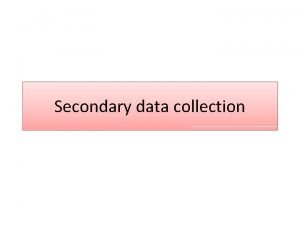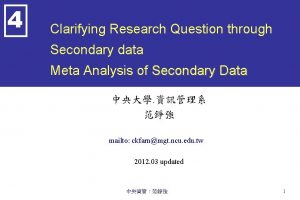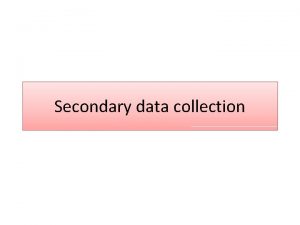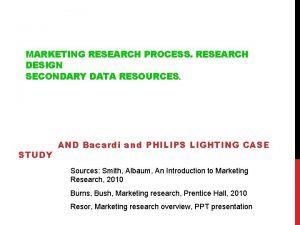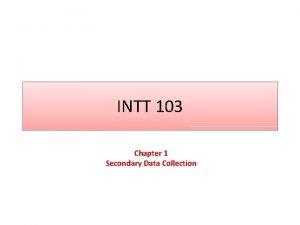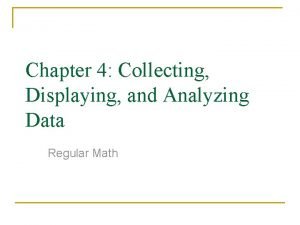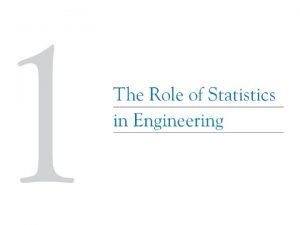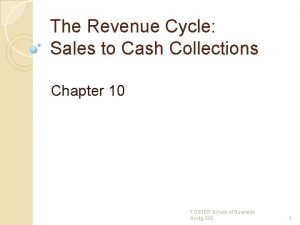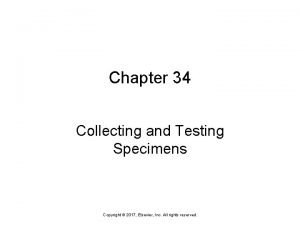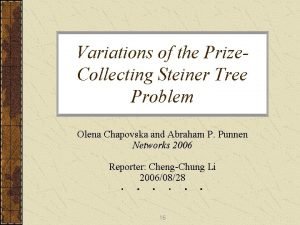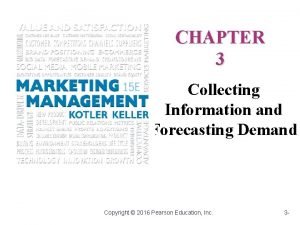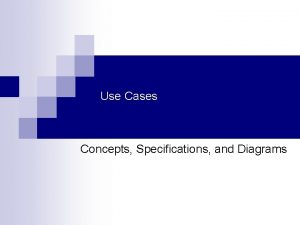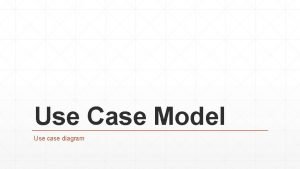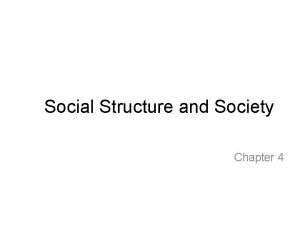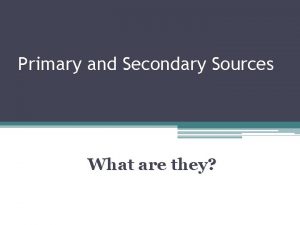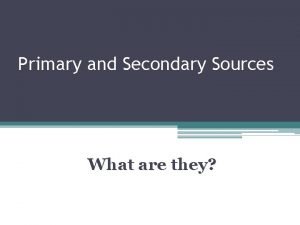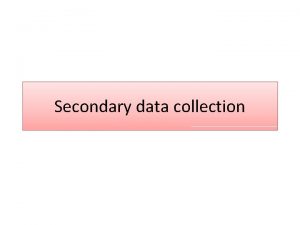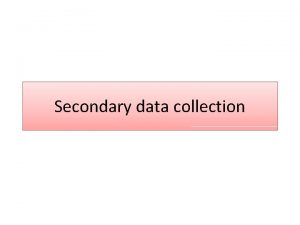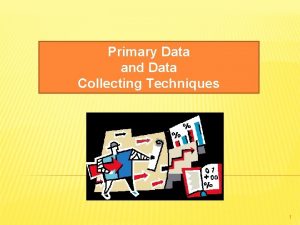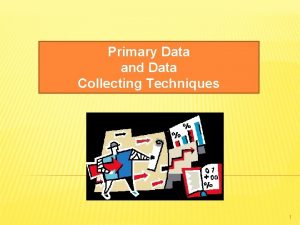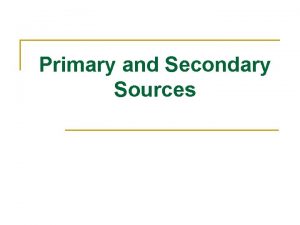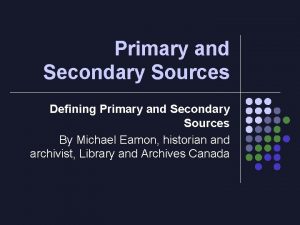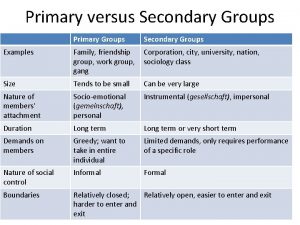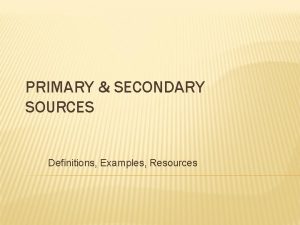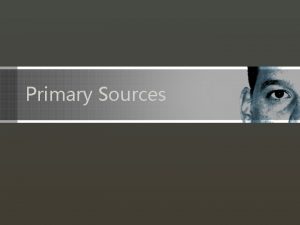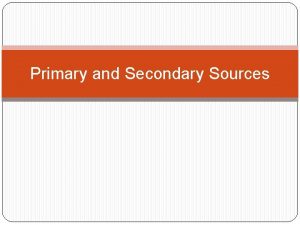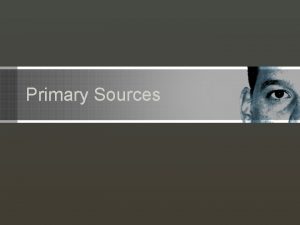Secondary data collection Collecting Data Primary Data Secondary



















































































- Slides: 83

Secondary data collection

Collecting Data Primary Data Secondary International Intelligence Data

Secondary data are data that have already been collected (by somebody) for purposes other than the problem at hand. At face value this definition seems straightforward. (basit)

Secondary data, are data collected by someone other than the user. Common sources of secondary data for social and political science include censuses, organisational records and data collected through qualitative research. Primary data, by contrast, are collected by the investigator conducting the research.

Primary data are originated by a researcher for the specific purpose of addressing the problem at hand.

Primary Data consists of a collection of original primary data. It is often undertaken after the researcher has gained some insight into the issue by reviewing secondary research or by analyzing previously collected primary data. Primary data can be collected by: - Survey (questionnaire) - Observation - Experiment - Projection

International intelligence can be defined as qualified observations of events and developments in the international environment. The use of the word ‘observations’ is presented in a wide sense to include a variety of types of data.

International intelligence (IB) is a set of theories, methodologies, processes, architectures, and technologies that transform raw data into meaningful and useful information for international purposes.

Advantages of secondary data Secondary data are easily accessible relatively inexpensive quickly obtained

Secondary data can help us: 1. Diagnose(teşhis) the research problem 2. Develop an approach to the problem 3. Develop a sampling plan 4. Formulate an appropriate research design (for example, by identifying the key variables to measure or understand) 5. Answer certain research questions and test some hypotheses 6. Interpret primary data with more insight 7. Validate qualitative research findings

Disadvantages of secondary data Because secondary data have been collected for purposes other than the problem at hand, their usefulness to the current problem may be limited in several important ways, including relevance and accuracy. The objectives, nature and methods used to collect the secondary data may not be appropriate to the present situation. Also, secondary data may be lacking in accuracy or may not be completely current or dependable. Before using secondary data, it is important to evaluate them according to a series of factors.

Criterias for evaluating secondary data Specifications and research design Error and accuracy Currency: when the data were collected Objective: the purpose for which the data were collected Nature: the content of the data Dependability: how dependable are the data?

Classification of secondary data


Published external secondary sources

Guides are an excellent source of standard information. A guide may help identify other important sources of directories, trade associations and trade publications.

Directories are helpful for identifying individuals or organisations that collect specific data. An example of a directory that you can examine on the Internet is the Central and Eastern European Business Directory.


Indexes It is possible to locate information on a particular topic in several different publications by using an index and abstracts. Indexes and abstracts can increase the efficiency of the search process. Several indexes and abstracts are available for both academic and business sources. Examples of newspaper indexes include the Financial Times Index (www. news. ft. com),

Published external secondary sources-1

Non-government statistical data Published statistical data are of great interest to researchers. Graphic and statistical analyses can be performed on these data to draw important insights. Examples of non governmental statistical data include trade associations such as the Swedish Tourism Trade Association (www. sverigeturism. se)


Government sources Turkish government and the EU also produce large amounts of secondary data. Each European country has its own statistical office which produces lists of the publications available.


Census data Most world countries produce either catalogues or newsletters that describe the array seri of census publications available and the plans for any forthcoming census. ( )



Published external secondary sources-2

Periodicals Periodical literature (also called a periodical publication) is a published work that appears in a new edition on a regular schedule. The most familiar examples are the newspaper, often published daily, or weekly; or the magazine, typically published weekly, monthly or as a quarterly.

Published external secondary sources-2

Statistical data are periodicals published by government or non-governments, also can be published nationally or internationally.

In academia, proceedings are the collection of academic papers published in the context of an academic conference. They are usually distributed as printed volumes or in electronic form either before the conference opens or after it has closed. They are the written record of the work that is presented to fellow researchers.

The collection of papers is organized by one or more persons, who form the editorial team. The quality of the papers is typically ensured by having external people read the papers before they are accepted in the proceedings. This process is called reviewing.


A journal is usually referred to as a diary a newspaper or other periodical, in the literal sense of one published each day many publications issued at stated intervals, such as magazines, or scholarly journals, academic journals, or the record of the transactions of a society, are often called journals. In academic use, a journal refers to a serious, scholarly publication that is peerreviewed.

Published external secondary sources-2

An academic journal is a peer-reviewed periodical in which scholarship relating to a particular academic discipline is published. The term academic journal applies to scholarly publications in all fields; this article discusses the aspects common to all academic field journals. Scientific journals and journals of the quantitative social sciences vary in form and function from journals of the humanities and qualitative social sciences.

Published external secondary sources-2

Social Sciences Citation Index (SSCI) is an interdisciplinary citation index product of Thomson Reuters' Healthcare & Science division. It was developed by the Institute for Scientific Information (ISI) from the Science Citation Index. This citation database covers some 2, 474 of the world's leading journals of social sciences across more than 50 disciplines. This database product provides information to identify the articles cited most frequently and by what publisher and author





Published external secondary sources-2

Non-indexed journals are peer-reviewed but not cited in any indexes. There are many conditions in order to be an indexed journal.




Published external secondary sources-2

Non-peered(akran, emsal)journals are usually non-scientific journal, but can be include some scientific data or information about any subjects. These journals do not have review boards.

Published external secondary sources-2




Komputerised databases

Online databases Databases, stored in computers, that require a telecommunications network to access.

Internet databases Databases that can be accessed, searched analysed on the Internet. It is also possible to download data from the Internet and store it on the computer or an auxiliary device.

Offline databases Databases that are available on diskette or CD-ROM.

Bibliographic databases Databases composed of citations to articles in journals, magazines, newspapers, marketing research studies, technical reports, government documents, and the like. They often provide summaries or abstracts of the material cited. (www. theses. com)

Numeric databases Databases containing numerical and statistical information that may be important sources of secondary data.

Full-text databases Databases that contain the complete text of secondary source documents comprising the database. World Advertising Research Center WARC (www. warc. com) A full text database or a complete text database is a database that contains the complete text of books, dissertations, journals, magazines, newspapers or other kinds of textual documents.

special-purpose databases For example, the Non-Governmental Organisation NGO directory (www. rec. org/REC/Databases/NGODirectory/ NGOfind. html) helps to track down information about environmental organisations working in central and eastern Europe.

Syndicated sources of secondary data

syndicated services, are companies that collect and sell common pools of data designed to serve information needs shared by a number of clients. These data are not collected with a focus on a specific political problem, but the data and reports supplied to organizations can be personalized to fit specific needs. For example, public opinion pull conducted for political parties.


Syndicated data from households Surveys Various syndicated services regularly conduct surveys and omnibus surveys(çok amaçlı gözatım). In general, these surveys involve interviews with a large number of respondents using a pre-designed questionnaire. Mail diary panels are samples of respondents who provide specified information at regular intervals over an extended period of time. These respondents may be organisations, households or individuals, although household diary panels are most common. Electronic scanner services The following example illustrates the nature and scope of electronic scanner services as undertaken by A. C. Nielsen, who conduct consumer panel services in 18 countries around the world.





Internal Data Sources A vital source of secondary data comes from within organisations that commission görevlendirme business research, namely internal secondary data. These data are generally seen as being ‘operational data’, i. e. data that represent the daily activities and transactions of a business. ( ) Daily transactions may be held in different departments such as sales, accounts or human resources and stored in different manners.

Many companies see the benefits of compiling comprehensive information about their customers and invest great amounts in developing and maintaining a customer database. The customer database for many companies is used to drive all business strategies. Customer data can be created by companies from past records, promotional devices such as competitions or direct response advertising. (derlemek) The database is used to stimulate business activities, and the response from these activities is fed back to improve and update it.

Public relations (PR) is the practice of managing the spread of information between an individual or an organization and the public. Public relations may include an organization or individual gaining exposure to their audiences using topics of public interest and news items that do not require direct payment.

Public relations: Voters complaints, and voters recommendations, results of the voter panels.

Geodemographic data The ability to create those links and to graphically display analyses has been achieved with the development of geodemographic information systems (GIS). At a base level, a GIS matches geographic information with demographic information, allowing analyses to be presented on thematic maps.

Thematic maps Maps that solve marketing problems. They combine geography with demographic information and a company’s sales data or other proprietary information and are generated by a computer.



Data warehouse A data warehouse is as much a process of gathering disparate farklı data, converting it into a consistent format that can aid political decisionmaking, as it is a configuration of software and hardware. ( ) Data warehouses empower users by providing them with access to a whole array of information in an organisation, making it available for use in other applications.

Datawarehouse 1 Is a collection of integrated databases designed to support managerial decision making and problem solving. 2 Essentially becomes a giant database that can include survey data held in a database format. 3 Physically separates an organisation’s operational data systems from its decision support systems.

Data mining is a process of discovering meaningful correlations, patterns and trends by shifting through large amounts of data stored in repositories. The process uses pattern recognition as well as statistical and mathematical techniques. Data mining should not be confused with datawarehousing. The datawarehouse could be termed a ‘repository’ or a place where large amounts of sometimes disparate sources of data are stored; data mining is a process that depends upon access to the data held in that repository.

Examples of what data mining aims to do: ■ Classify customers into specific categories that are meaningful to decision-makers ■ Identify potential target markets that possess the characteristics that decision makers seek ■ Forecast sales or the use of services ■ Discover which types of products or services are purchased together ■ Discover patterns and trends over time, such as ‘after graduation, students take a holiday’, and be able to show the probabilities associated with different holiday types.

Time to run out!!!
 Data collection procedure example
Data collection procedure example Data collection secondary data sources
Data collection secondary data sources Management research question hierarchy
Management research question hierarchy Primary data
Primary data Syndicated sources of secondary data
Syndicated sources of secondary data Primary data and secondary data
Primary data and secondary data Nominal scale
Nominal scale A major advantage of primary data collection is that
A major advantage of primary data collection is that Collecting highly parallel data for paraphrase evaluation
Collecting highly parallel data for paraphrase evaluation Collecting and displaying data
Collecting and displaying data Samples of collecting engineering data
Samples of collecting engineering data Landsat collection 1 vs collection 2
Landsat collection 1 vs collection 2 Documentary collection definition
Documentary collection definition The primary objective in cash collection is to:
The primary objective in cash collection is to: Loop of henle
Loop of henle Interstitium
Interstitium Internal nares
Internal nares Corbett maths.com
Corbett maths.com Coupon collecting problem
Coupon collecting problem Collecting gas over water
Collecting gas over water Chapter 34 collecting and testing specimens
Chapter 34 collecting and testing specimens The lymphatic system consists of
The lymphatic system consists of Collecting gas over water
Collecting gas over water Rutherford stamp collecting
Rutherford stamp collecting Boy scout coin collecting merit badge
Boy scout coin collecting merit badge Collecting gas over water
Collecting gas over water Dr frost maths
Dr frost maths Prize collecting steiner tree
Prize collecting steiner tree Collecting banker
Collecting banker Collecting information and forecasting demand
Collecting information and forecasting demand Hard tag questions
Hard tag questions Visceral layer
Visceral layer Collecting ducts
Collecting ducts Collecting duct meaning
Collecting duct meaning Selective reabsorption in the proximal convoluted tubule
Selective reabsorption in the proximal convoluted tubule Collecting ducts
Collecting ducts Collecting ducts
Collecting ducts Nitrogenous waste
Nitrogenous waste Collecting duct meaning
Collecting duct meaning Marketing information system
Marketing information system Data collection procedure and data analysis
Data collection procedure and data analysis The primary pigments are _____ the primary colors.
The primary pigments are _____ the primary colors. Primary and secondary effects of a tectonic hazard
Primary and secondary effects of a tectonic hazard Primary secondary stakeholders
Primary secondary stakeholders Pink
Pink Primary and secondary effects of a tectonic hazard
Primary and secondary effects of a tectonic hazard Wastewater treatment process primary secondary tertiary
Wastewater treatment process primary secondary tertiary Use case primary and secondary actors
Use case primary and secondary actors Use case primary and secondary actors
Use case primary and secondary actors Maximum efficiency of transformer
Maximum efficiency of transformer Transferring of data from auxiliary storage to main storage
Transferring of data from auxiliary storage to main storage Tissue system in plants
Tissue system in plants Euthyroid sick syndrome
Euthyroid sick syndrome Levothyroxine side effects
Levothyroxine side effects Translational research institute on pain in later life
Translational research institute on pain in later life Primary and secondary retroperitoneal organs
Primary and secondary retroperitoneal organs Primary secondary tertiary colors
Primary secondary tertiary colors Tolerance model of succession
Tolerance model of succession Formation of alcohols
Formation of alcohols Storage devices of computer
Storage devices of computer Oxidation of primary alcohols
Oxidation of primary alcohols Software
Software Primary and secondary agents of socialization
Primary and secondary agents of socialization Merton’s typology
Merton’s typology Semi circular bunds
Semi circular bunds Primary bronchi and secondary bronchi
Primary bronchi and secondary bronchi Thoracentesis indications
Thoracentesis indications What is primary sources
What is primary sources Primary evidence vs secondary evidence
Primary evidence vs secondary evidence Setline planting in gujarat
Setline planting in gujarat Primary secondary tertiary
Primary secondary tertiary Secondary to tertiary structure
Secondary to tertiary structure Is autobiography a primary source
Is autobiography a primary source Sources of history images
Sources of history images Primary evidence vs secondary evidence
Primary evidence vs secondary evidence Primary evidence vs secondary evidence
Primary evidence vs secondary evidence Primary sources of information
Primary sources of information Secondary light sources
Secondary light sources Ukraine preschool
Ukraine preschool Secondary reinforcers
Secondary reinforcers Primary transport and secondary transport
Primary transport and secondary transport Primary vs secondary neurulation
Primary vs secondary neurulation Primary needs and secondary needs
Primary needs and secondary needs Dermatology morphology
Dermatology morphology
